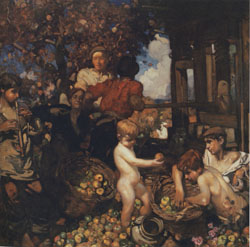As I write, the British pound is in sharp decline against a wide range of currencies, including even the Zimbabwean dollar! No, there hasn't been an editorial mishap and this is not the financial section of The Japan Times. I just mention these facts of economic decline to add some perspective to the enigma of Frank Brangwyn, a British artist who was extremely popular and internationally celebrated during his lifetime but largely forgotten by the time he died in 1956, the very year in which the Suez Crisis saw the death of the British Empire as an effective world power.
The career of the artist, now showcased at an exhibition at the National Museum of Western Art, is fascinating for a number of reasons that shed light on the fate of Britain. But, this being Japan, the real reason behind the exhibition is the artist's local connections, in particular with the Japanese industrialist Kojiro Matsukata (1865-1950), whose extensive collection formed the basis of the NMWA when it was founded in 1959.
The pair became friends in London during World War I, when Matsukata's firm was making a mint mass-producing ships for the Allies at a time when German U-boats were taking an enormous toll. As an industrialist familiar with the milieu of the shipyards, Matsukata was attracted by Brangwyn's impressive proletarian art, which showed industry and the nobility of labor in a gruff, unsentimental way.


















With your current subscription plan you can comment on stories. However, before writing your first comment, please create a display name in the Profile section of your subscriber account page.